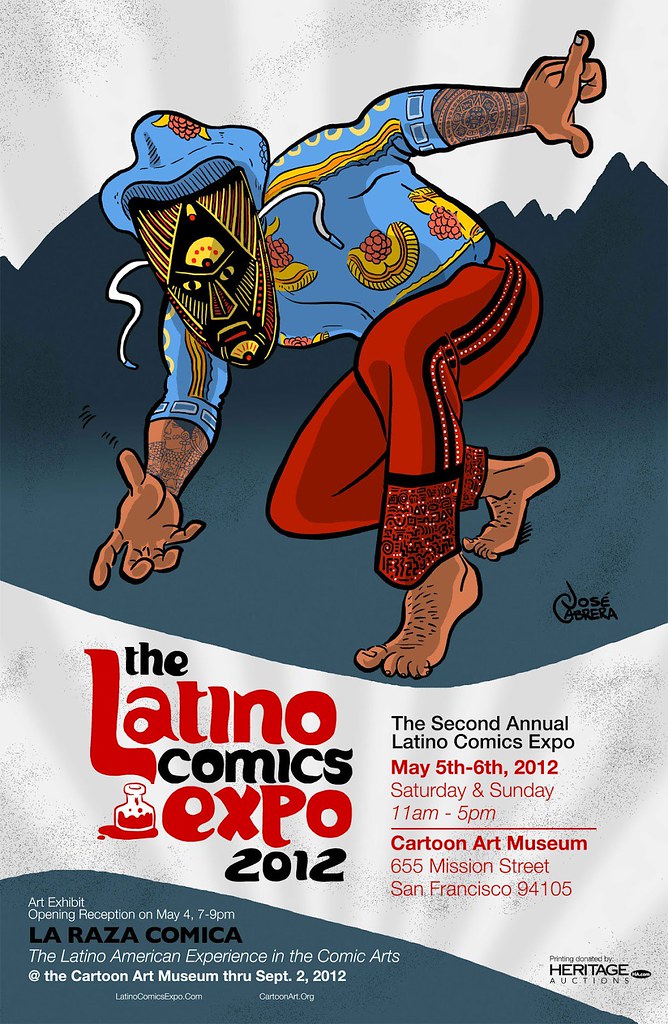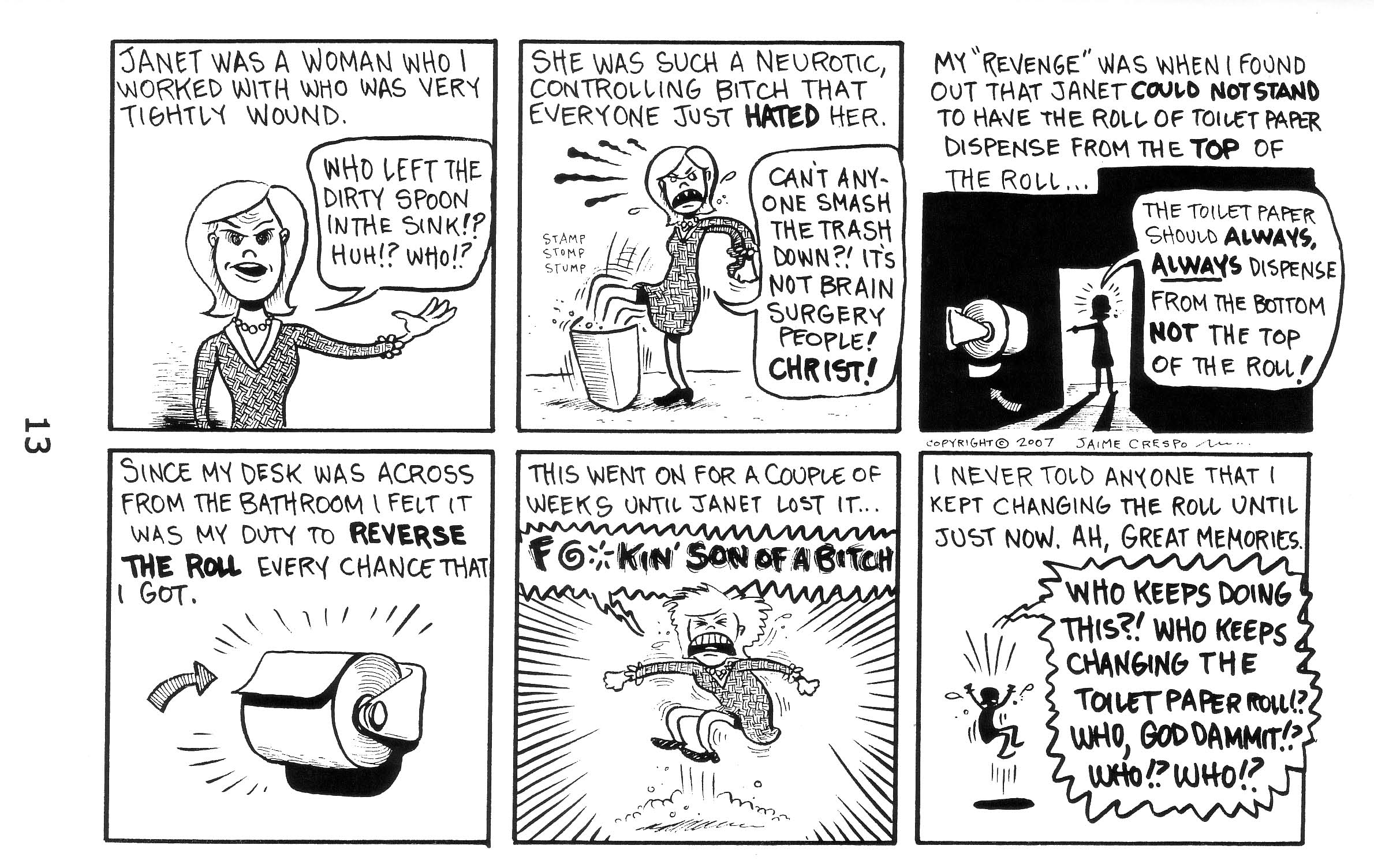 |
| The poster for the exhibit |
 |
| By Lalo Alcaraz |
 |
| By Jaime Crespo |
Growls and Grawlixes of a Comics Adventurer
 |
| The poster for the exhibit |
 |
| By Lalo Alcaraz |
 |
| By Jaime Crespo |
 |
| From left: W.J.T. Mitchell and Spiegelman |
 |
| From left: Chute, Burns, Clowes, Seth, and Ware |
 |
| Comics: Philosophy and Practice Auditorium |
Leaving Argentina and all my friends in the comics community was quite painful. I spent the past year getting to know exciting people, learning about their lives and reading works that they’ve spent time and energy creating. When I started going to events last April, I didn’t know anyone, but the crowd was friendly and eventually I had a network of acquaintances. I wouldn’t have traded this sense of community for anything in the world. But, wait, I did. I left Argentina for the United States.
I went to the Chicago Zine Fest this past weekend and realized that I am exactly where I was last year, but this time I’m in Chicago. Zinesters (or fanzineros) have an intricate, interwoven community that I know absolutely nothing about. At first glance, most people seem pretty friendly, but probably have relationships that began years ago when they were angsty teenagers, eager to write. Do I feel discouraged, starting from square one? I still have my researcher status because I’ve been working on a report for Viñetas Series comparing income sources for Argentine and American comics creators. I do honestly want to learn about how the Chicago comics scene works. My impressions so far are favorable. Unlike in Argentina, there is a large female presence. One reason given for this is that in mainstream media there is a lack of publishing by and about women. Self-publishing offers an opportunity to people not given a voice by conventional publishing companies. Along this note, there was also a large queer community. It’s quite different from the Argentine comics community.
I started by talking with people who have done exciting things in the Chicago zine scene. Anne Elizabeth Moore, a decades-long zine creator, academic, and former Fulbright recipient, participated in an interesting talk about gender, race, and sexuality in zine culture. I spoke with her afterwards about fanzine culture in Argentina in the 90’s and later bought her book about her Fulbright teaching Indonesian women how to create zines. Sarah Becan hosted one of the workshops I attended and presented about her experiences publishing a compilation of her zines through Kickstarter. Kikstarter is a “funding platform for creative projects.” Basically, you submit a proposal and random people on the Internet send you money if they like the project. It is an alternative way of self-publishing comics that otherwise would not be able to exist. In terms of my research, Kickstarter offers a new opportunity for artists seeking to be published.
Zine Fest came at a moment when I was greatly missing Argentina. Even though I don’t know anyone and have to start over, I’m glad there is something in Chicago I can look forward to and enjoy.
(please scroll down for english version) |
Charla y proyección a cargo de Claire Denton Spalding
En el Muelle Flotante* de
La Dársena_Plataforma de Pensamiento e Interacción Artística
presentamos el jueves 22 de febrero de 2012, a las 19:30 hrs a:
la investigadora norteamericana Claire Denton Spalding
Claire Denton-Spalding ha pasado un año en Argentina con una beca Fulbright estudiando la historieta argentina desde un punto de vista económico. Ha asistido numerosos congresos de la historieta y entrevistado a 30 guionistas, dibujantes, periodistas, editores independientes y dueños de comiquerías no sólo en Buenos Aires, sino también en Córdoba y la Patagonia.
Claire hablará y proyectará sus experiencias y los hallazgos de su investigación en Plataforma La Dársena. También será una forma de despedirse hasta el año que viene, ya que Claire regresa a Chicago a fines de febrero.

http://thepapertigress.
*El Muelle Flotante es el lugar de Plataforma La Dársena para la cooperación artística, el diálogo, la difusión y las presentaciones de artistas y asociaciones locales e internacionales. Está abierto a recepción de proyectos (presentaciones de libros, videoproyecciones, charlas) y funciona también por invitación.
Miércoles 22, 19:30 hrs. Entrada gratuita.
La Dársena_Plataforma de de Pensamiento e Interacción Artística
Mario Bravo 298, Buenos Aires, Argentina
Dirección: Azul Blaseotto y Eduardo Molinari
plataformaladarsena.blogspot.
..............................
An economic perspective on contemporary argentinian comic
Screening and talk and with Claire Denton Spalding
On the FLOATING QUAY * of
La Dársena_Plataforma de Pensamiento e Interacción Artística
The Dock_Platform of Thinking and Artistic Interaction
we present on tuesday the 22.th of february at 19:30
the northamerican comic searcher Claire Denton Spalding
Claire Denton-Spalding spent the past year studying the economic aspects of the Argentine comic with a Fulbright Grant. She has attended numerous comics conferences and conducted interviews with thirty writers, artists, journalists, independent publishers, and comic store owners from not only Buenos Aires, but Córdoba and Patagonia as well. On February 22nd, she will present her experiences and findings at La Dársena Platform. It will also be a way of saying goodbye until next year because Claire will be returning to Chicago at the end of February.
On the Floating Quay Claire D-S will present a summary of her investigation in Argentina, whose name is the title of this show.
*The Floating Quay is a permanent section of La Dársena: the place for artistic cooperation, dialogue, diffusion, and presentations by local and international artists and organizations. Floating Quay Works by invitation, but is also open to receiving projects (book presentations, videoprojections, talks).
+ about Claire: http://thepapertigress.
Wednesday 22th. february at 19:30 hrs. Free entrance
La Dársena_Plataforma de de Pensamiento e Interacción Artística
Mario Bravo 298, Buenos Aires, Argentina
plataformaladarsena.blogspot.
The Dock_Platform of Thinking and Artistic Interaction
is a cultural and activist space, a dialogic-critical tool in Buenos Aires. Here we develope collective processual practices of contemporary art and thought in context. We create transdiciplinary networks, pedagogical projects and art methods based researchs. We realize non-profit activities, based on solidarity and reciprocity, looking for more cultural biodiversity, social incidence and communitarian Buen Vivir / Good Living. We encourage the continued blurring of aesthetic and political borders, the expansion of glocal debate and dialogue.